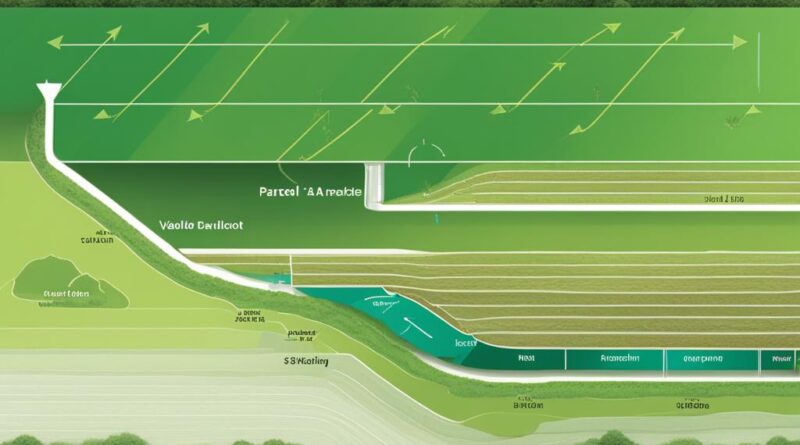Guide on How to Split Property to Sell: Simple Steps and Tips
Selling a part of your property can be a complex process, especially if you have an existing mortgage. It’s important to understand the legal and financial considerations involved. This guide will provide you with simple steps and valuable tips on how to successfully split property to sell.
Key Takeaways:
- Splitting property to sell requires understanding legal and financial considerations.
- If you have a mortgage, you may need permission from your lender to subdivide and sell parts of the property.
- The land market operates differently from the existing homes market, requiring different sales tactics.
- Before selling a part of your property, check local zoning laws and obtain lender approval if applicable.
- To sell a part of your property, understand your target buyer, make the land ready, price it carefully, and market it effectively.
Is it Possible to Sell Just a Part of Your Property?
When considering selling a property, you may wonder if it’s possible to sell only a portion of it. The answer depends on several factors, including the ownership status and any existing mortgage on the property.
If you own the property outright, you generally have the legal right to sell any part of it. However, if you still have a mortgage on the property, things can become more complicated. Most mortgages include a due-on-sale clause, which means that selling any portion of the property without the lender’s approval can trigger the clause, requiring you to pay off the entire mortgage at once.
To avoid triggering the due-on-sale clause, you will need to seek permission from your lender to subdivide and sell parts of the property. The lender will consider factors such as the loan status, remaining equity, and overall financial situation before granting approval. It’s important to note that obtaining lender approval can take time, so it’s essential to start the process well in advance of your desired selling timeline.
Table: Pros and Cons of Selling a Part of Your Property
| Pros | Cons |
|---|---|
| Opportunity to cash in on unused portions of the property | Potential triggering of the due-on-sale clause |
| Flexibility to sell portions that are no longer needed or desired | Possible complications and delays in obtaining lender approval |
| Increased liquidity by turning a portion of the property into cash | Potential impact on the value and marketability of the remaining property |
Considering these factors, it’s crucial to weigh the pros and cons before deciding to sell a part of your property. Consulting with a real estate professional and a mortgage lender can provide valuable guidance specific to your situation and help you make an informed decision.
Understanding the Differences in the Land Market
The land market operates differently from the existing homes market. When it comes to selling land, it is essential to understand the unique dynamics at play. Land buyers have different needs and perspectives compared to homebuyers, which means that selling land requires different sales tactics.
Unlike selling a home, where buyers can see the finished product, potential buyers of land often need to be convinced of the unseen potential. This could include showcasing the possibilities for development, highlighting the scenic beauty of the location, or emphasizing the investment potential.
It’s important to note that the land market is generally less active than the market for existing homes. This means that it may take longer to sell a part of your property compared to selling an entire lot. Patience and persistence are key when it comes to selling land.
Land Buyers vs Homebuyers
Land buyers and homebuyers have different motivations and priorities. While homebuyers are often focused on factors like location, size, and amenities, land buyers are looking for potential and possibilities. They might be interested in building their dream home, starting a business, or investing in land for future development.
Selling land requires understanding these unique perspectives and tailoring your sales approach accordingly. This could involve marketing the land’s potential uses, providing information on local zoning regulations, and highlighting any unique features of the property.

| Differences Between Land Buyers and Homebuyers | Land Buyers | Homebuyers |
|---|---|---|
| Priorities | Unseen potential, future development, investment opportunities | Location, size, amenities, immediate livability |
| Marketing Approach | Emphasize potential uses, zoning regulations, unique features | Showcase finished product, highlight amenities, staging |
| Selling Timeframe | Land sales can take longer due to less active market | Existing homes market can be faster-paced |
Understanding the differences between land buyers and homebuyers is crucial for a successful land sale. By tailoring your approach, highlighting the potential of the land, and being patient throughout the process, you can maximize your chances of selling a part of your property.
Knowing the Rules for Selling Land
Selling a part of your property requires a thorough understanding of the rules and regulations involved. Before proceeding, it is crucial to check if local zoning laws permit subdivision. Some areas have minimum lot size requirements that must be met before selling a portion of your property. Violating these regulations can lead to legal complications and penalties.
If you have a mortgage on the property, obtaining your lender’s approval is essential. Your lender may require a partial loan payoff or a payment out of your current equity before allowing the subdivision. This approval process can take several weeks or even months, so it’s important to factor in this timeline when planning your sale.
By adhering to local zoning laws and obtaining the necessary approvals from your lender, you can ensure a legally compliant and successful sale of a part of your property.
| Rules for Selling Land | Local Zoning Laws | Lender’s Approval for Subdivision |
|---|---|---|
| Check if local zoning laws allow for subdivision | Ensure compliance with minimum lot size requirements | Obtain lender’s approval for selling a part of the property |
| Violating zoning laws can lead to legal complications | Consult local authorities or professionals if unsure | Lender may require partial loan payoff or payment out of current equity |
| Understanding local regulations is crucial for a successful sale | Consider the impact of zoning laws on property value | Allow sufficient time for the lender’s approval process |
Complying with the rules for selling land, including local zoning laws and obtaining lender approval, is essential for a smooth and legal transaction. Familiarize yourself with the laws and regulations specific to your area, consult professionals if needed, and allow enough time for the necessary approvals. By doing so, you can navigate the process successfully and maximize the value of the part of your property you wish to sell.
Steps to Sell a Part of Your Property
When it comes to selling a part of your property, there are several important steps to follow in order to ensure a successful sale. Understanding your target buyer, making the land ready, pricing your property accurately, and implementing effective marketing strategies are key factors to consider. Let’s explore these steps in detail:
1. Understand your target buyer
Before listing your property, it’s crucial to identify your target buyer. Consider the type of buyer who would be interested in purchasing the specific portion of land you are selling. Take into account factors such as location, amenities, and potential uses of the land. By understanding your target buyer’s needs and preferences, you can tailor your marketing efforts to effectively reach and attract potential buyers.
2. Make the land ready
Prior to listing your property, ensure that the portion of land you are selling is well-maintained and visually appealing. Clean up the area by cutting the grass, removing weeds and trash, and addressing any necessary repairs. Additionally, it’s advisable to have a survey done to clearly mark the property boundaries, providing potential buyers with accurate information. By making the land ready, you increase its marketability and attract serious buyers.
3. Price your property carefully
Pricing your property appropriately is crucial for a successful sale. Consider factors such as the size of the land, its potential uses, and the current market demand for similar properties. Conduct research on recent sales of comparable land to determine a competitive and realistic price. Consulting with a real estate professional can provide valuable insights and guidance when determining the right price for your property.
4. Market your land
Implementing effective marketing strategies is essential to attract potential buyers and generate interest in your property. Utilize online platforms and multi-listing services to reach a wider audience. Design visually appealing advertisements and signs to showcase the unique features and potential of the land. Engage with neighbors and local communities to spread the word about the available land for sale. By maximizing exposure and effectively marketing your land, you increase the chances of finding the right buyer.
By following these steps and implementing effective strategies, you can successfully sell a part of your property. Understanding your target buyer, making the land ready, pricing accurately, and implementing a strong marketing plan are key factors in ensuring a successful sale.

Selling Subdivided Land with a Mortgage: Steps and Requirements
If you have a mortgage on the land you want to subdivide, there are extra steps to consider. Subdividing land with a mortgage requires careful planning and compliance with various requirements. Here are the essential steps you need to follow:
Step 1: Check Eligibility for Subdivision
Before proceeding with the subdivision process, you need to ensure that the land is eligible for subdivision according to local zoning laws. Some areas have specific requirements for lot size, setbacks, and access that must be met. Conduct thorough research or consult with a professional to determine if your property can be subdivided legally.
Step 2: Obtain Lender’s Permission
Since you have a mortgage on the land, you will need to obtain permission from your lender to proceed with the subdivision. Contact your lender and provide them with details about your plan. They may require additional documentation such as a survey, plat, or subdivision plan. The lender will review your request and set specific conditions for granting permission.
Step 3: Develop a Subdivision Plan
Once you have obtained the lender’s permission, you will need to develop a subdivision plan. This plan should outline how the land will be divided and any improvements or infrastructure that may be required. Engaging with a professional surveyor or land planner can help ensure the plan meets all necessary requirements and regulations.
Step 4: Obtain Necessary Approvals and Permits
Before proceeding with the actual subdivision, you will need to obtain all necessary approvals and permits from local authorities. This may include obtaining clearance from zoning boards, environmental agencies, or other relevant departments. Make sure to follow all procedures and provide any required documentation to obtain these approvals.
Step 5: Make Required Improvements
Depending on the subdivision plan and local regulations, you may need to make certain improvements to the land before selling the subdivided portions. This could include installing utilities, creating access roads, or addressing any environmental concerns. Ensure that all required improvements are completed according to the approved plan.
Step 6: Ensure Compliance with Lender Requirements
Throughout the subdivision process, it is essential to comply with all requirements set by your lender. This may include maintaining a current loan status, meeting specific loan-to-value ratios, or adhering to particular conditions stated by the lender. Failing to comply with these requirements can have consequences, such as triggering the “due on sale” clause and requiring immediate repayment of the mortgage.
Subdividing land with a mortgage requires thorough planning, compliance with regulations, and coordination with your lender. By following these steps and ensuring all necessary requirements are met, you can successfully sell subdivided land while maintaining the value of your property.

The Importance of Lender Approval for Subdivision
Obtaining lender approval for subdividing your property is a crucial step in the process. Without the lender’s approval, selling a part of your property can have significant consequences, including the potential impact on your mortgage collateral.
When you subdivide your property and sell a portion of it, the value of the remaining property may be affected. This can pose a risk to the lender since the collateral for the mortgage is tied to the property’s value. Lenders require approval to ensure that their interests are protected and that the overall value of the property remains intact.
In order to obtain lender approval, there are specific requirements that need to be met. These requirements can vary depending on the lender, but typically include a minimum loan-to-value ratio, compliance with subdivision laws and regulations, and a thorough evaluation of the proposed subdivision plan. It’s important to consult with your lender early in the process to fully understand their specific requirements.
Requirements for Lender Approval:
- Minimum loan-to-value ratio
- Compliance with subdivision laws and regulations
- Thorough evaluation of the proposed subdivision plan
By obtaining lender approval, you can ensure that you are meeting all necessary requirements and protecting your interests as well as the lender’s. It’s important to fully understand the impact that subdividing and selling a part of your property can have on your mortgage, and to work closely with your lender to navigate the approval process.

Lender Requirements for Subdividing Property
When subdividing a property with a mortgage, there are several requirements that lenders typically have in order to approve the subdivision. These requirements ensure that the lender’s interests are protected and that the property remains a viable collateral for the mortgage. Here are some common lender requirements:
Application for Release of Security
Before proceeding with the subdivision, you will need to submit an application for release of security to your lender. This application formally requests their approval for the subdivision and outlines the details of the proposed subdivision plan. The application must include supporting documents such as a survey, plat, or aerial map depicting the original land and the proposed subdivision, an appraisal of the property, and a subdivision application if required by local authorities.
Survey and Appraisal Documentation
Lenders require a detailed survey of the property, which clearly identifies the boundaries of the proposed subdivision. This survey helps the lender assess the impact of the subdivision on the remaining property and ensures that the proposed lots meet all necessary requirements. Additionally, an appraisal of the property is typically required to determine its current market value. The appraisal helps the lender assess the financial viability of the subdivision and evaluate the potential impact on the overall value of the property.
Conditions for Lender Approval
Lenders have specific conditions for approving subdivision requests. These conditions may vary depending on the lender and the specific circumstances of the subdivision. Some common conditions include ensuring that the property’s loan status is current and in good standing, verifying the priority of the lender’s lien on the property, evaluating the location of any existing structures and their impact on the proposed subdivision, and ensuring compliance with local subdivision laws and regulations.
| Requirement | Description |
|---|---|
| Application for Release of Security | An application requesting lender approval for the subdivision, including supporting documents such as surveys, appraisals, and subdivision applications. |
| Survey and Appraisal Documentation | A detailed survey of the property and an appraisal to determine its current market value. |
| Conditions for Lender Approval | Specific conditions set by the lender, including loan status, lien priority, impact of existing structures, and compliance with local laws. |
Meeting these lender requirements is essential to obtain approval for subdividing a property with a mortgage. It is recommended to consult with your lender early in the process to understand their specific requirements and ensure a smooth subdivision process.
Selling Subdivided Land with a Mortgage
When selling a subdivided land with a mortgage, there are important considerations to keep in mind. First and foremost, obtaining lender approval is crucial. Before proceeding with the sale, you must seek permission from your lender, as selling a part of the property can impact the value of the remaining land and the collateral for the mortgage. Failure to obtain lender approval may result in the requirement to pay off the entire mortgage when selling the subdivided portion.
Additionally, it is essential to check the equity in the property. Selling a part of the land should be done with careful consideration of the remaining equity to ensure that it is a financially viable decision. Understanding the equity in the property will help you determine if selling the subdivided land is a profitable endeavor.
When engaging in the process of selling subdivided land, it is advisable to work with professionals who can guide you through the legal and financial complexities. They can assist in ensuring compliance with lender requirements, local regulations, and assist in navigating the steps involved in selling a part of your property with a mortgage.

Table 9.1: Key Considerations for Selling Subdivided Land with a Mortgage
| Considerations | Details |
|---|---|
| Lender Approval | Obtain permission from the lender before selling a part of the property to avoid triggering the “due on sale” clause. |
| Equity Check | Evaluate the remaining equity in the property to ensure that selling the subdivided land is financially viable. |
| Professional Guidance | Work with professionals who can provide guidance on legal and financial aspects, ensuring compliance and a smooth selling process. |
By obtaining lender approval, carefully evaluating equity, and seeking professional guidance, you can successfully sell subdivided land with a mortgage. This allows you to capitalize on the unused portions of your property while retaining the value of the remaining land.
Considerations for Subdividing Land
Subdividing land can offer numerous benefits, including increasing profitability and enhancing the marketability of your property. However, before embarking on the subdivision process, it is essential to take several considerations into account to ensure a successful outcome.
One crucial aspect to address is conducting feasibility studies. These studies help evaluate the viability and potential of the subdivided land, taking into account factors such as market demand, infrastructure requirements, and regulatory restrictions. Feasibility studies provide valuable insights that can guide your decision-making process and help you determine if subdividing your land is a financially sound investment.
Another significant consideration is understanding the local zoning laws pertaining to subdivisions. Each area has its own set of regulations and requirements, such as minimum lot sizes, setback restrictions, and other land-use specifications. Familiarizing yourself with these laws and ensuring compliance will help streamline the subdivision process and avoid potential legal issues.
Furthermore, it is important to assess the marketability of the subdivided land. Consider the target buyers who would be interested in purchasing the divided parcels and tailor your marketing efforts accordingly. Highlight the unique features and potential uses of the subdivided lots to attract potential buyers, emphasizing the value and possibilities they offer.
By carefully considering these factors and conducting thorough research, you can make informed decisions when it comes to subdividing your land. Subdivision can open up opportunities for increased profitability and tap into the untapped potential of your property.
Conclusion
The process of splitting property to sell, especially when there is an existing mortgage, can be challenging. However, by following this comprehensive guide and considering the tips provided, you can navigate through the complexities successfully.
It’s important to consult professionals and conduct thorough research to understand the legal and financial considerations involved. By adhering to local zoning laws, obtaining lender approval, and meeting necessary requirements, you can subdivide and sell a part of your property without any issues.
Remember, understanding your target buyer, making the land ready, pricing it appropriately, and effectively marketing your land are crucial steps to maximize your chances of selling successfully. Keep in mind the specific needs and market dynamics of your area to make informed decisions throughout the process.
So, if you’re considering subdividing and selling a part of your property, use this guide as a valuable resource and take advantage of the tips provided to ensure a smooth and successful transaction.
FAQ
Is it possible to sell just a part of my property?
Yes, you can legally sell any part of your property unless there is a legal agreement stating otherwise. However, if you have a mortgage, you may need permission from your lender to subdivide and sell parts of the property.
What are the differences in the land market compared to the existing homes market?
The land market operates differently from the existing homes market. Selling land requires different sales tactics, as potential buyers often need to be convinced of the unseen potential rather than what is visible. Additionally, the land market is less active, which means it may take longer to sell a part of your property compared to selling an entire lot.
What are the rules for selling land?
Before considering selling a part of your property, it is crucial to check if local zoning laws allow for subdivision. Some areas have minimum lot size requirements that must be met. Additionally, if you have a mortgage, you will need your lender’s approval to sell a part of the property.
What are the steps to sell a part of my property?
To successfully sell a part of your property, you need to follow these steps: understanding your target buyer, making the land ready, pricing your property carefully, and marketing your land effectively.
What are the steps and requirements for selling subdivided land with a mortgage?
If you have a mortgage on the land you want to subdivide, extra steps include checking if the land is eligible for subdivision according to zoning laws, obtaining permission from your lender, developing a subdivision plan, obtaining necessary approvals and permits, and making required improvements to the land.
Why is lender approval needed for subdivision?
Lender approval is necessary because subdividing and selling part of the property can reduce the value of the retained property, affecting the collateral for the mortgage. Not obtaining lender approval can result in the need to pay off the entire mortgage when selling a subdivided portion.
What do banks require for subdividing a property?
To obtain lender approval for subdivision, you need to submit an application for release of security with necessary documentation such as a survey, plat, or aerial map depicting the original land and the proposed subdivision, an appraisal, and a subdivision application. Lenders have conditions for approving subdivision requests, including the property’s loan status, its priority lien, the location of existing structures, and compliance with local subdivision laws.
Can I sell subdivided land with a mortgage?
Yes, once you have followed the necessary steps and obtained your lender’s permission, you can proceed to sell the subdivided land with a mortgage. It is important to ensure that you have sufficient equity in the property and that you comply with all requirements set by the lender and local authorities.
What should I consider before deciding to subdivide land?
Before deciding to subdivide, it is crucial to conduct feasibility studies, understand local zoning laws, and consider factors like infrastructure requirements and existing regulations.

